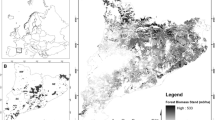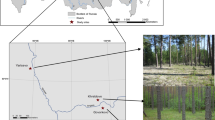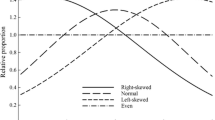Abstract
The Mediterranean basin is a fire-prone area and is expected to continue being so according to projected climate and socioeconomic changes. Sustainable exploitation of forest biomass could have a positive effect on wildfire hazard mitigation. A modelling approach was used to compare how four different Scenarios for biomass collection for energy use affect fire behaviour and potential burnt area at landscape level under extreme meteorological conditions in a typical Mediterranean Massif. A case study of Pinus halepensis stands in Valencia (Eastern Spain) was conducted. The FARSITE simulator was used to evaluate the burnt area and fire behaviour parameters. Simulations predicted a significant increase in the burnt area and the values of most fire behaviour parameters in a Scenario of rural abandonment, relative to the current situation. Biomass management through thinning reduced canopy bulk density; however, no differences in the values of the main fire behaviour parameters were detected. Thinning and understory clearing, including biomass collection in large shrub fuel model areas, significantly reduces fire hazard. Forest biomass sustainable harvesting for energy is expected to reduce fire hazard if management includes intense modification of fuel models, comprising management of shrub biomass at the landscape level. Strong modification of forest fuel models requires intensive silvicultural treatments. Therefore, forest biomass collection for energy in the Mediterranean basin reduces fire hazard only if both tree and shrub strata are managed at landscape level.



Similar content being viewed by others
References
Agee JK, Skinner CN (2005) Basic principles of fuel reduction treatments. For Ecol Manag 211:83–96
Alexander ME, Cruz MG (2013) Are the applications of wildland fire behaviour models getting ahead of their evaluation again? Environ Model Softw 41:65
Álvarez A, Gracia M, Retana J (2012) Fuel types and crown fire potential in Pinus halepensis forests. Eur J For Res 131:463–474
Arca B, Duce P, Laconi M, Pellizaro G, Salis M, Spano D (2007) Evaluation of FARSITE simulator in Mediterranean maquis. Int J Wildland Fire 16:563–572
Barbour RJ, Fried JS, Daugherty PJ, Christensen G, Fight R (2008) Potential biomass and logs from fire-hazard-reduction treatments in southwest Oregon and northern California. For Policy Econ 10(6):400–407
Bedia J, Herrera S, Camia A, Moreno JM, Gutiérrez JM (2014) Forest fire danger projections in the Mediterranean using ENSEMBLES regional climate change scenarios. Clim Change 122:185
Bond WJ, Keeley JE (2005) Fire as a global ‘herbivore’: the ecology and evolution of flammable ecosystems. Trends Ecol Evol 20:387–394
Bradstock RA, Hamill KA, Collins L, Price O (2010) Effects of weather, fuel and terrain on fire severity in topographically diverse landscapes of south-eastern Australia. Landsc Ecol 25:607–619
Brotons L, Aquilué N, de Cáceres M, Fortin M-J, Fall A (2013) How fire history, fire suppression practices and climate change affect wildfire regimes in Mediterranean landscapes. PLoS ONE 8(5):e62392. doi:10.1371/journal.pone.0062392
Byram GM (1959) Combustion of forest fuels. In: Brown AA, Davis KP (eds) Forest fires: control and use. McGraw-Hill, New York, pp 155–182
Calkin DE, Cohen JD, Finney MA, Thompson MP (2014) How risk management can prevent future wildfire disasters in the wildland-urban interface. PNAS 111(2):746–751
Cardil A, Eastaugh CS, Molina D (2015) Extreme temperature conditions and wildland fires in Spain. Theor Appl Climatol 122(1):219–228
Collins B, Miller JD, Thode AE, Kelly M, van Wagtendonk JW, Stephens SL (2009) Interactions among wildland fires in a long-established Sierra Nevada natural fire area. Ecosystems 12:114–128
Cram DS, Baker TT, Boren JC (2006) Wildland fire effects in silviculturally treated versus untreated stands of New Mexico and Arizona. USDA Forest Service, Rocky Mountain Research Station, Research Paper RMRSRP-55. (Fort Collins, CO)
Cruz MG, Alexander ME (2010) Assessing crown fire potential in coniferous forests of western North America: a critique of current approaches and recent simulation studies. Int J Wildland Fire 19(4):371–398
Cruz MG, Alexander ME, Wakimoto RH (2004) Modelling the likelihood of crown fire occurrence in conifer forest stands. For Sci 50(5):640–657
Dailey S, Fites J, Reiner A, Mori S (2008) Fire behaviour and effects in fuel treatments and protected habitat on the Moonlight Fire. Forest Service (AMSET) Report. p 63 http://www.fs.fed.us/r5/hfqlg
Duguy D, Alloza JA, Röder A, Vallejo R, Pastor F (2007) Modelling the effects of landscape fuel treatments on fire growth and behaviour in a Mediterranean landscape (eastern Spain). Int J Wildland Fire 16:619–632
Espelta JM, Verkaik I, Eugenio M, Lloret F (2008) Recurrent wildfires constrain long-term reproduction ability in Pinus halepensis Mill. Int J Wildland Fire 17:579–585
Fernandes PM (2013) Fire-smart management of forest landscapes in the Mediterranean basin under global change. Landsc Urban Plan 110:175–182
Fernandes PM (2015) Empirical support for the use of prescribed burning as a fuel treatment. Curr For Rep 1:118–127
Fernandes PM, Barros AG, Pinto A, Santos JA (2016) Characteristics and drivers of extremely large wildfires in the western Mediterranean Basin. J Geophys Res Biogeosci. doi:10.1002/2016JG003389
Fernández C, Vega JA (2014) Shrub recovery after fuel reduction treatments and a subsequent fire in a Spanish heathland. Plant Ecol 215(11):1233–1243
Finney MA (2003) Calculating fire spread rates across random landscapes. Int J Wildland Fire 12(2):167–174
Finney MA (2006) An overview of FlamMap fire modeling capabilities. In: Fuels management—how to measure success: conference proceedings. 2006 March 28–30; Portland, Oregon. Proceedings RMRS-P-41. Fort Collins, CO: US Department of Agriculture, Forest Service, Rocky Mountain Research Station. pp 213–220
Finney MA, Seli RC, McHugh CW, Ager AA, Bahro B, Agee JK (2007) Simulation of long-term landscape-level fuel treatment effects on large wildfires. Int J Wildland Fire 16:712–727
Flannigan MD, Krawchuk MA, de Groot WJ, Wotton M, Gowman LM (2009) Implications of changing climate for global wildland fire. Int J Wildland Fire 18:483–507
González JR, Palahí M, Trasobares A, Pukkala T (2006) A fire probability model for forest stands in Catalonia (north-east Spain). Ann For Sci 63:169–176
González JR, Trasobares A, Palahí M, Pukkala T (2007) Predicting stand damage and tree survival in burned forests in Catalonia (North–East Spain). Ann For Sci 64:733–742
González-Olabarría JR, Pukkala T (2011) Integrating fire risk considerations in landscape-level forest planning. For Ecol Manag 261:278–287
González-Olabarría JR, Rodríguez F, Fernández-Landa A, Mola-Yudego B (2012) Mapping fire risk in the Model Forest of Urbión (Spain) based on airborne LiDAR measurements. For Ecol Manag 282:149–156
Graham RT, McCaffrey S, Jain TB (2004) Science basis for changing forest structure to modify wildfire behavior and severity. USDA Forest Service General Techical Report RMRS-GTR-120. P 43
Graham RT, Jain TB, Loseke M (2009) Fuel treatments, fire suppression, and their interaction with wildfire and its impacts: the Warm Lake experience during the Cascade Complex of wildfires in central Idaho, 2007. Gen. Tech. Rep. RMRS-GTR-229. Fort Collins, CO: U.S. Department of Agriculture, Forest Service, Rocky Mountain Research Station. p 36
Hudak AT, Rickert I, Morgan P, Strand E, Lewis SA, Robichaud P, Hoffman C, Holden ZA (2011) Review of fuel treatment effectiveness in forests and rangelands and a case study from the 2007 megafires in Central Idaho USA. USDA Forest Service/UNL Faculty Publications. Paper p 172
Hudiburg TW, Law BE, Wirth C, Luyssaert S (2011) Regional carbon dioxide implications of forest bioenergy production. Nat Clim Change 1(8):419–423
Iversen K, Van Demark R (2006) Integrating fuel reduction management with local bioenergy operations and businesses—A community responsibility. Biomass Bioenerg 30(4):304–307
Jiménez E, Vega JA, Ruiz-González AD, Guijarro M, Alvarez-González JG, Madrigal J, Cuiñas P, Hernando C, Fernández-Alonso JM (2013) Carbon emissions and vertical pattern of canopy fuel consumption in three Pinus pinaster Ait. active crown fires in Galicia (NW Spain). Ecol Eng 54:202–209
Jiménez E, Vega-Nieva D, Rey E, Fernández C, Vega JA (2016) Midterm fuel structure recovery and potential fire behaviour in a Pinus pinaster Ailt. Forest in northern central Spain after thinning and mastication. Eur J For Res 135(4):675–686
Lafortezza R, Tanentzap AJ, Elia M, John R, Sanesi G, Chen J (2015) Prioritizing fuel management in urban interfaces threatened by wildfires. Ecol Indic 48:342–347
Lehmkuhl JF, Kennedy M, Ford ED, Singleton PH, Gaines WL, Lind RL (2007) Seeing the forest for the fuel: integrating ecological values and fuels management. For Ecol Manag 246:73–80
Lydersen JM, North MP, Collins BM (2014) Severity of an uncharacteristically large wildfire, the Rim Fire, in forests with relatively restored frequent fire regimes. For Ecol Manag 328:326–334
Malico I, Pinto Carrajola J, Gomes C, Lima JC (2016) Biomass residues for energy production and habitat preservation. Case study in a montado area in Southwestern Europe. J Clean Prod 112:3676–3683
Marino E, Guijarro M, Hernando C, Madrigal J, Díez C (2011) Fire hazard after prescribed burning in a gorse shrubland: implications for fuel management. J Environ Manag 92:1003–1011
Marino E, Hernando C, Madrigal J, Guijarro M (2014a) Short-term effect of fuel treatments on fire behaviour in a mixed heathland: a comparative assessment in an outdoor wind tunnel. Int J Wildland Fire 23:1097–1107
Marino E, Hernando C, Planelles R, Madrigal J, Guijarro M, Sebastián A (2014b) Forest fuel management for wildfire prevention in Spain: a quantitative SWOT analysis. Int J Wildland Fire 23:373–384
Martínez J, Vega-García C, Chuvieco E (2009) Human-caused wildfire risk rating for prevention planning in Spain. J Environ Manag 90:1241–1252
Martínez-Fernández J, Chuvieco E, Koutsias N (2013) Modelling long-term fire occurrence factors in Spain by accounting for local variations with geographically weighted regression. Nat Hazards Earth Syst Sci 13:311–327
Martinson EJ, Omi PN (2008) Assessing mitigation of wildfire severity by fuel treatments—an example from the Coastal Plain of Mississippi. Int J Wildland Fire 17:415–420
McGaughey RJ, Carson WW (2003) Fusing LIDAR data, photographs, and other data using 2D and 3D visualization techniques. In: Proceedings of terrain data: applications and visualization–making the Connection, October 28–30, 2003. pp 16–24
Miller JD, Safford HD, Crimmins M, Thode AE (2009) Quantitative evidence for increasing forest fire severity in the Sierra Nevada and Southern Cascade Mountains, California and Nevada, USA. Ecosystems 12:16–32
Mitchell SR, Harmon ME, O’Connell KEB (2009) Forest fuel reduction alters fire severity and long-term carbon storage in three Pacific Northwest ecosystems. Ecol Appl 19(3):643–655
Montero G, Cañellas I, Ruiz-Peinado R (2001) Growth and yield models for Pinus halepensis Mill. Invest Agr Sist Recur For 10(1):179–201
Moreira F, Viedma O, Arianoutsou M, Curt T, Koutsias N, Rigolot E, Barbati A, Corona P, Vaz P, Xanthopoulos G, Mouilloti F, Bilgili E (2011) Landscape-wildfire interactions in southern Europe: implications for landscape management. J Environ Manag 92:2389–2402
Moriondo M, Good P, Durao R, Bindi M, Giannakopoulos C, Corte-Real J (2006) Potential impact of climate change on fire risk in the Mediterranean area. Clim Res 31:85–95
Moritz MA, Batllori E, Bradstock RA, Gill AM, Handmer J, Hessburg PF, Leonard J, McCaffrey S, Odion DC, Schoennagel T, Syphard AD (2014) Learning to coexist with wildfires. Nature 515:58–66
Neary DG, Zieroth EJ (2007) Forest bioenergy system to reduce the hazard of wildfires: white Mountains. Arizona Biomass Bioenerg 31(9):638–645
North M, Collins B, Stephens S (2012) Using fire to increase the scale, benefits, and future maintenance of fuels treatments. J For 110(7):392–401
Nuñez-Regueira L, Proupin-Castineiras J, Rodriguez-Anon JA (2004) Energy evaluation of forest residues originated from shrub species in Galicia. Bioresour Technol 91(2):215–221
Oliveira TM, Barros AM, Ager AA, Fernandes PM (2016) Assessing the effect of a fuel break network to reduice burnt area and wildfire risk transmission. Int J Wildland Fire 25:619–632
Omi PN (2015) Theory and practice of Wildland fuels management. Curr For Rep 1:100–117
Ortega M, Saura S, González-Avila S, Gómez-Sanz V, Elena-Rosselló R (2012) Landscape vulnerability to wildfires at the forest-agriculture interface: half-century patterns in Spain assessed through the SISPARES monitoring framework. Agrofor Syst 85(3):331–349
Parks SA, Miller C, Nelson CR, Holden ZA (2014) Previous fires moderate burn severity of subsequent wildland fires in two large Western US wilderness areas. Ecosystems 17:29–54
Pasalodos-Tato M, Ruiz-Peinado R, del Río M, Montero G (2015) Shrub biomass accumulation and growth rate models to quantify carbon stocks and fluxes for the Mediterranean region. Eur J For Res 134(3):537–553
Pausas JG, Llovet J, Rodrigo A, Vallejo R (2008) Are wildfires a disaster in the Mediterranean basin?—A review. Int J Wildland Fire 17(6):713–723
Pérez S, Renedo CJ, Ortiz A, Delgado F, Fernández I (2014) Energy potential of native shrub species in northern Spain. Renew Energy 62:79–83
Price OF, Penman TD, Bradstock RA, Boer M, Clarke H (2015) Biogeographical variation in the potential effectiveness of prescribed fire in south-eastern Australia J Biogeogr 42(11):2234–2245
Prichard SJ, Peterson DL, Jacobson K (2010) Fuel treatments reduce the severity of wildfire effects in dry mixed conifer forest, Washington, USA. Can J For Res 40:1615–1626
Quílez R, Chinchilla S (2012) Caracterización de modelos de combustible en la provincia de Valencia. Flamma 3(2):31–40
Raymond CL, Peterson DL (2005) Fuel treatments alter the effects of wildfire in a mixed-evergreen forest. Oregon, USA. Can J For Res 35:2981–2995
Regos A, Aquilué N, Retana J, De Cáceres M, Brotons L (2014) Using unplanned fires to help suppressing future large fires in Mediterranean forests. PLoS ONE 9(4):e94906. doi:10.1371/journal.pone.0094906
Regos A, Aquilué N, López I, Codina M, Retana J, Brotons L (2016) Synergies between forest biomass extraction for bioenergy and fire suppression in Mediterranean ecosystems: insights from a storyline-and-simulation approach. Ecosystems 19:1–17. doi:10.1007/s10021-016-9968-z
Reinhardt E, Holsinger L (2010) Effects of fuel treatments on carbon-disturbance relationships in forests of the northern Rocky Mountains. For Ecol Manage 259:1427–1435
Reinhardt DE, Keane RE, Calkin DE, Cohen JD (2008) Objectives and considerations for wildland fuel treatment in forested ecosystems of the interior western United States. For Ecol Manag 256(12):1997–2006
Rodrigo A, Retana J, Picó X (2004) Direct regeneration is not the only response of Mediterranean forests to large fires. Ecology 85:716–729
Rothermel RC (1972) A mathematical model for predicting fire spread in wildland fuels. Research Paper INT 115 Ogden UT, USDA Forest Service
Ruiz AD, Vega JA, Álvarez-González JG (2009) Construction of empirical models for predicting Pinus sp. dead fine fuel moisture in NW Spain. I: response to changes in temperature and relative humidity. Int J Wildland Fire 18:71–83
Ruiz-Mirazo J, Roble AB, González-Rebollar JL (2011) Two-year evaluation of fuelbreaks grazed by livestock in the wildfire prevention program in Andalusia (Spain). Agr Ecosyst Environ 141:13–22
Ruiz-Peinado R, del Río M, Montero M (2011) New models for estimating the carbon sink capacity of Spanish softwood species. For syst 20(1):176–188
Sacchelli S, De Meo I, Paletto A (2013) Bioenergy production and forest multifunctionality: a trade-off analysis using multiscale GIS model in a case study in Italy. Appl Energy 104:10–20
Schmidt DA, Taylor AH, Skinner CN (2008) The influence of fuels treatment and landscape arrangement on simulated fire behavior, Southern Cascade range, California. For Ecol Manag 255:3170–3184
Schwilk DW, Keeley JE, Knapp EE, McIver J, Bailey JD, Fettig CJ, Fiedler CE, Harrod RJ, Moghaddas JJ, Outcalt KW, Skinner CN, Stephens SL, Waldrop TA, Yaussy DA, Youngblood A (2009) The national Fire and Fire Surrogate study: effects of fuel reduction methods on forest vegetation structure and fuels. Ecol Appl 19:285–304
Scott JH, Burgan RE (2005) Standard fire behavior fuel models: a comprehensive set for use with Rothermel’s surface fire spread model. Gen Tech Rep RMRS-GTR-153. USDA Forest Service
Stephens SL (1998) Evaluation of the effects of silvicultural and fuels treatments on potential fire behavior in Sierra Nevada mixed-conifer forests. For Ecol Manag 105:21–35
Stephens SL, Moghaddas JJ (2005) Experimental fuel treatment impacts on forest structure, potential fire behavior, and predicted tree mortality in a California mixed conifer forest. Forest Ecol Manag 215:21–36
Stephens SL, Moghaddas JJ, Edminster C, Fiedler CE, Haase S, Harrington M, Keeley JE, Knapp EE, McIver JD, Metlen K, Skinner CN, Youngblood A (2009a) Fire treatment effects on vegetation structure, fuels, and potential fire severity in western U.S. forests. Ecol Appl 19:305–320
Stephens SL, Moghaddas JJ, Edminster C, Fiedler CE, Haase S, Harrington M, Keeley JE, Knapp EE, McIver JD, Metlen K, Skinner CN, Youngblood A (2009b) Fire treatment effects on vegetation structure, fuels, and potential fire severity in western US forests. Ecol Appl 19(2):305–320
Turco M, Llasat MC, von Hardenberg J, Provenzale A (2014) Climate change impacts on wildfires in a Mediterranean environment. Clim Change 125:369–380
Van Wagner CE (1977) Conditions for the start and spread of crown fire. Can J For Res 7:23–34
Viegas DX, Piñol J, Viegas MT, Ogaya R (2001) Estimating live fuel moisture content using meteorologically-based indexes. Int J Wildland Fire 10:223–240
Waldrop TA, Yaussy DA, Phillips RJ, Hutchinson TA, Brudnak L, Boerner REJ (2008) Fuel reduction treatments affect stand structure of hardwood forests in Western North Carolina and Southern Ohio, USA. For Ecol Manag 255:3117–3129
Wimberly MC, Cochrane MA, Baer AD, Pabst K (2009) Assessing fuel treatment effectiveness using satellite imagery and spatial statistics. Ecol Appl 19(6):1377–1384
Wold H (1985) Partial least squares In: Kotz S, Johnson NL (eds) Encyclopedia of statistical sciences Vol 6, John Wiley & Sons, New York, pp 581–591
Acknowledgments
This study was developed by the contract between IBERDROLA enterprise and INIA (CON13-005) in the frame of LIFE+ European project “Bioenergy and Fire Prevention” (Life 09 EN-E.000450). This work was completed in the frame of SCALyFOR project (AGL2013-46028-R), GEPRIF project (RTA2014-00011-C06-01) and MedWildFireLab project (PCIN-2013-141-C04-04). Thanks to Raúl Quílez from Consorcio de Bomberos de Valencia (Valencian Firefighters) for providing Forest Fuel Map and Meteorological Scenario. Thanks to Bioenergy and Fire Prevention European Project for providing processed LiDAR data and field plots data. Climate data were provided from climatic records and projections elaborated by the Spanish Meteorological Agency (AEMET).
Author information
Authors and Affiliations
Corresponding author
Additional information
Communicated by Agustín Merino.
Electronic supplementary material
Below is the link to the electronic supplementary material.
Rights and permissions
About this article
Cite this article
Madrigal, J., Fernández-Migueláñez, I., Hernando, C. et al. Does forest biomass harvesting for energy reduce fire hazard in the Mediterranean basin? a case study in the Caroig Massif (Eastern Spain). Eur J Forest Res 136, 13–26 (2017). https://doi.org/10.1007/s10342-016-1004-5
Received:
Revised:
Accepted:
Published:
Issue Date:
DOI: https://doi.org/10.1007/s10342-016-1004-5




